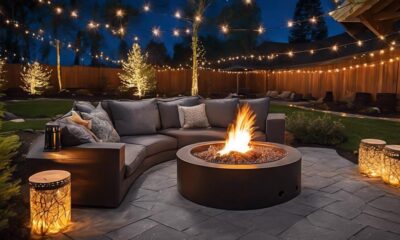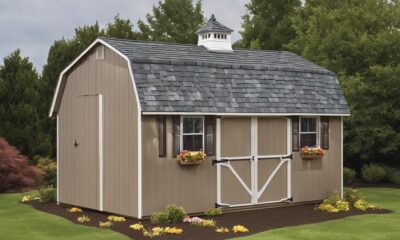Appliances
What Heat to Cook Pancakes
2025
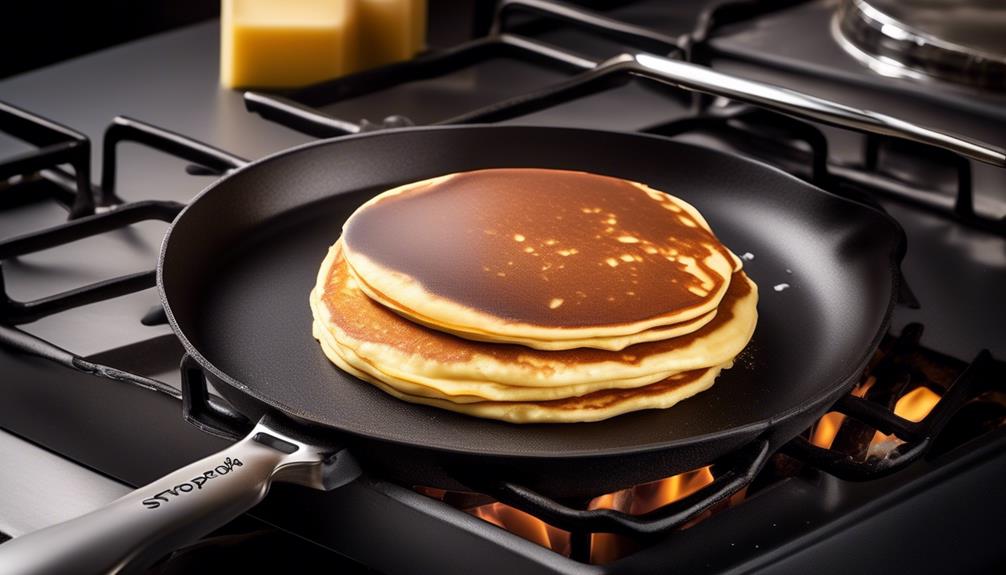
You have become skilled at pouring the ideal pancake batter onto the skillet, and now you must decide on the best heat setting to cook them at.
As we stand over the stove, pondering the ideal temperature for pancake perfection, it's easy to get caught up in the debate of high versus low heat. But fear not, for we are here to unravel this mystery and guide you through the science of achieving that golden-brown, fluffy pancake or delicate, thin crepe.
Let's embark on this culinary journey together and uncover the secrets of the perfect pancake heat.
Key Takeaways
- Controlling heat is crucial for even cooking and achieving desired texture and color.
- Ideal temperature for cooking pancakes is around 375°F (190°C).
- Preheating the cooking surface properly ensures even heat distribution.
- Adjust temperature for ideal moisture evaporation and fluffiness.
Importance of Heat Control
Controlling heat is crucial in ensuring that pancakes cook evenly and achieve the desired texture and color. Temperature control is essential for the perfect pancake.
When the cooking surface is too hot, the outside of the pancake may burn while the inside remains undercooked. Conversely, if the cooking surface is too cool, the pancake will take too long to cook, resulting in a dry and tough texture.
The ideal temperature for cooking pancakes is around 375°F (190°C). This temperature allows the pancake to cook through evenly without burning the exterior. It's important to preheat the cooking surface properly to ensure even heat distribution.
Using a non-stick griddle or skillet is recommended for optimal results. These cooking surfaces help to achieve an even heat distribution, preventing hot spots that can lead to uneven cooking. Additionally, the non-stick surface reduces the need for excess butter or oil, promoting a healthier cooking method.
Proper heat control and an appropriate cooking surface are fundamental factors in achieving the perfect pancake.
Finding the Right Temperature
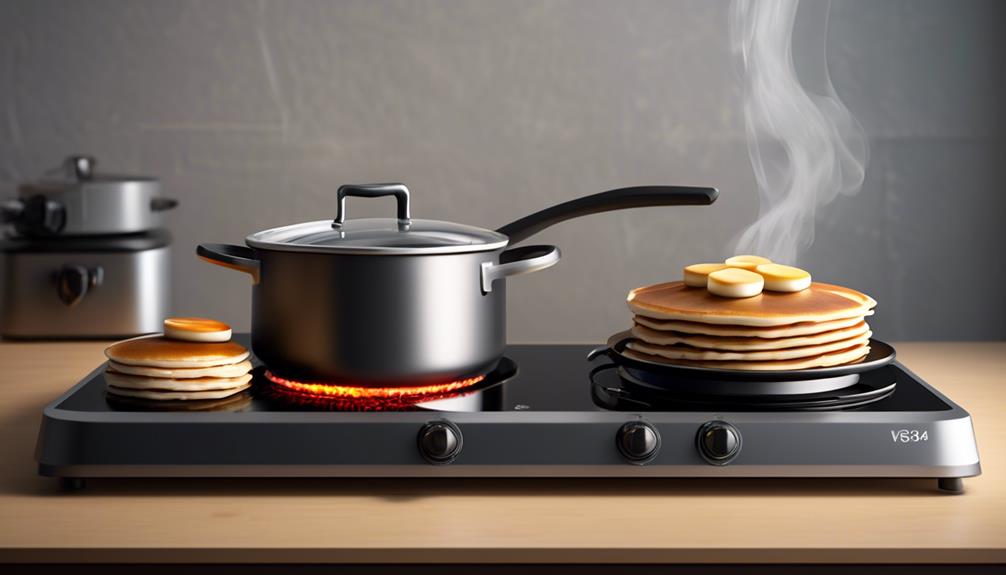
When cooking pancakes, finding the right temperature is crucial for achieving the perfect results. We need to consider the optimal heat level to ensure the pancakes cook evenly and reach the desired golden brown color.
Testing for readiness by sprinkling a few drops of water on the pan is a simple yet effective method to determine if the temperature is just right for cooking.
Optimal Heat Level
To achieve the perfect pancake, it's essential to start by preheating the cooking surface to a steady medium heat, approximately 350°F to 375°F, ensuring even and consistent cooking. Maintaining the optimal heat level is crucial for achieving pancakes with a golden-brown exterior and a fluffy interior.
Here are some key considerations:
- Flipping Technique: Master the art of flipping the pancake at the right time to ensure an evenly cooked surface without burning.
- Batter Consistency: Ensure the pancake batter isn't too thick or too runny, as this affects the cooking time and the final texture of the pancake.
- Even Heat Distribution: Use a flat griddle or non-stick pan to guarantee uniform heat distribution across the entire cooking surface.
- Adjusting Heat: Monitor the heat level and make necessary adjustments to prevent the pancakes from burning or undercooking.
- Resting Time: Allow the batter to rest for a few minutes before cooking to ensure optimal texture and rise.
Mastering these elements will elevate your pancake game to perfection.
Testing for Readiness
Testing pancake readiness can be accomplished by utilizing a droplet of water on the cooking surface to gauge whether it sizzles and evaporates, indicating the ideal temperature for pouring the batter. Once the cooking surface is at the right temperature, it's essential to ensure the pancake batter has the right consistency. The batter should be thick enough to pour, but still run off the spoon. To achieve this, adjust the amount of liquid in the batter accordingly. When pouring the batter onto the cooking surface, it should spread into a round shape on its own. To test for readiness to flip, look for bubbles forming on the surface of the pancake and the edges starting to look set. Use a spatula to gently lift and peek underneath for a golden brown color. Here's a helpful table to summarize pancake flipping techniques:
| Pancake Flipping Techniques | Description |
|---|---|
| The One-Handed Flip | Quickly and confidently flip the pancake with a flick of the wrist. |
| The Two-Spatula Flip | Use two spatulas to secure and flip the pancake. |
| The Air Flip | Toss the pancake into the air and catch it back in the pan. |
| The Slide and Flip | Slide the pancake to the edge of the pan before flipping. |
Consistent Pancake Cooking
Finding the right temperature for consistent pancake cooking is crucial to achieving a perfect golden brown color and fluffy texture. To master the art of consistent pancake cooking, follow these key principles:
- Uniform Heat Distribution: Ensure the griddle or pan is evenly heated to prevent uneven cooking.
- Thermometer Precision: Use a cooking thermometer to accurately measure the temperature, aiming for 375°F (190°C).
- Proper Pancake Flipping Technique: Master the art of flipping pancakes at the right time to avoid deflating the batter and achieve an even rise.
- Moisture Content: Adjust the temperature to achieve the ideal moisture evaporation, contributing to the fluffiness of the pancakes.
- Consistent Heat Control: Maintain a steady temperature throughout the cooking process to achieve consistent results.
Gas Stove Cooking Tips
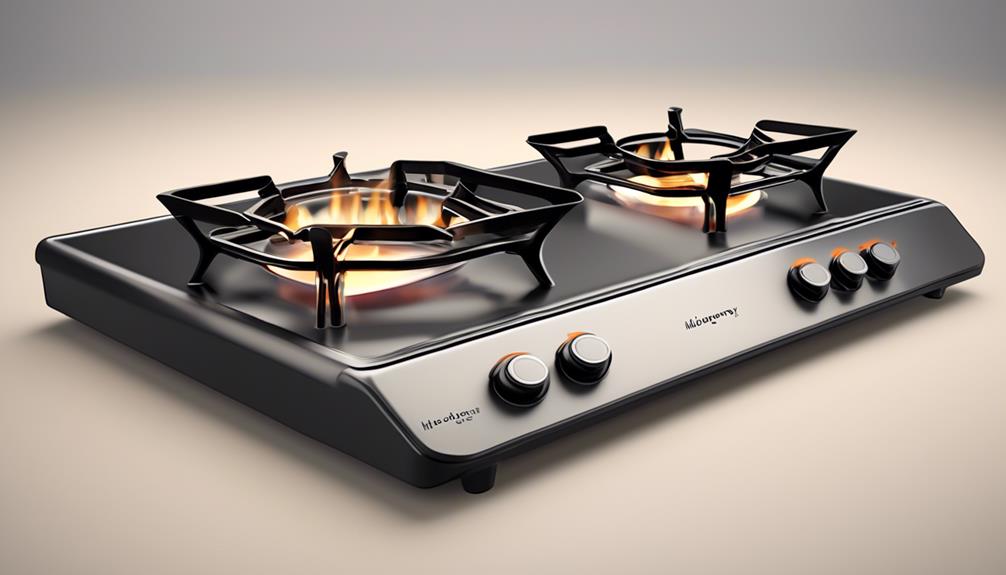
When cooking pancakes on a gas stove, it's crucial to adjust the flame to achieve the desired temperature for even cooking. Unlike electric stoves, gas stoves provide instant heat and precise control over the flame, allowing for quicker adjustments to maintain the ideal temperature.
To ensure consistent pancake cooking, it's essential to familiarize yourself with the gas stove's heat levels. Start by preheating the pan over medium heat and then adjusting the flame as needed throughout the cooking process. It's important to pay close attention to the size and color of the flames to gauge the intensity of the heat.
Additionally, using a heavy-bottomed pan can help distribute the heat evenly and prevent hot spots. When pouring the batter onto the pan, listen for a sizzling sound to ensure that the pan is at the right temperature.
Electric Stove Cooking Tips
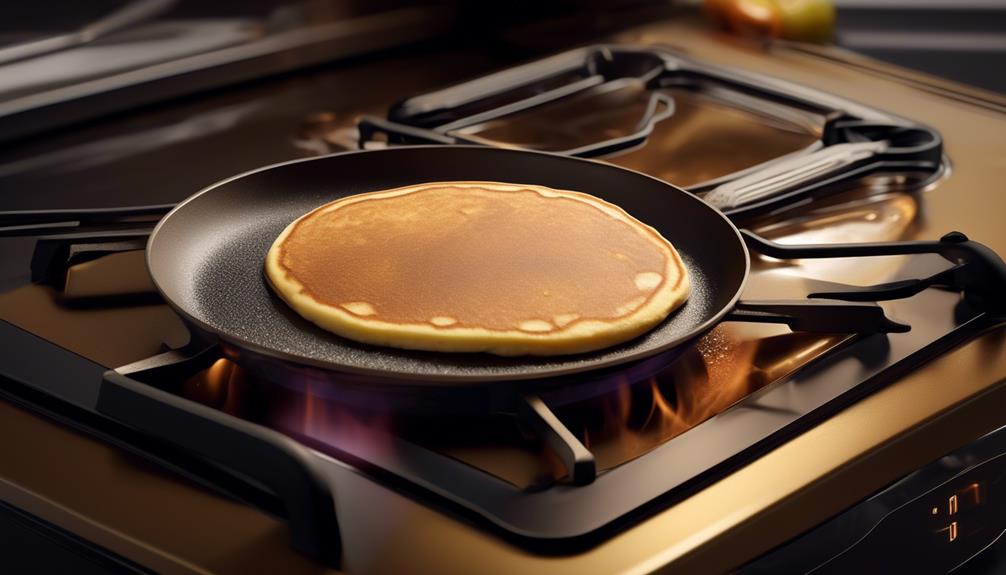
When cooking pancakes on an electric stove, it's important to understand the heat setting options and how they affect the cooking process.
By using the right heat setting, we can achieve even heat distribution, ensuring that the pancakes cook uniformly and without any burnt spots.
Understanding these key points will help us optimize our pancake-making experience on an electric stove.
Heat Setting Options
To achieve optimal cooking results when making pancakes on an electric stove, it's essential to carefully select the appropriate heat setting to ensure even and thorough cooking. When it comes to heat control and cooking techniques, there are several options to consider:
- Low Heat: Ideal for cooking pancakes evenly without burning them.
- Medium-Low Heat: Ensures a golden-brown color without overcooking the pancakes.
- Medium Heat: Suitable for a quicker cooking time while still achieving a golden-brown hue.
- Medium-High Heat: Useful for cooking pancakes faster, but requires close attention to prevent burning.
- High Heat: Not recommended for pancakes as it may lead to uneven cooking and scorching.
Understanding these heat setting options and their effects on cooking will ultimately result in perfectly cooked pancakes.
Even Heat Distribution
Considering the importance of heat control in achieving optimal pancake cooking results, a crucial factor to address is the even distribution of heat when using an electric stove.
Achieving even heat distribution is essential for consistent cooking. To ensure this, start by preheating the pan or griddle properly. This allows the entire cooking surface to reach the desired temperature, preventing hot spots. Additionally, using a heavy-bottomed or cast iron pan can help distribute heat more evenly.
Throughout the cooking process, maintaining a constant temperature is vital. Adjust the stove's heat settings as needed to prevent fluctuation in temperature, which can lead to uneven cooking.
Induction Stove Cooking Tips
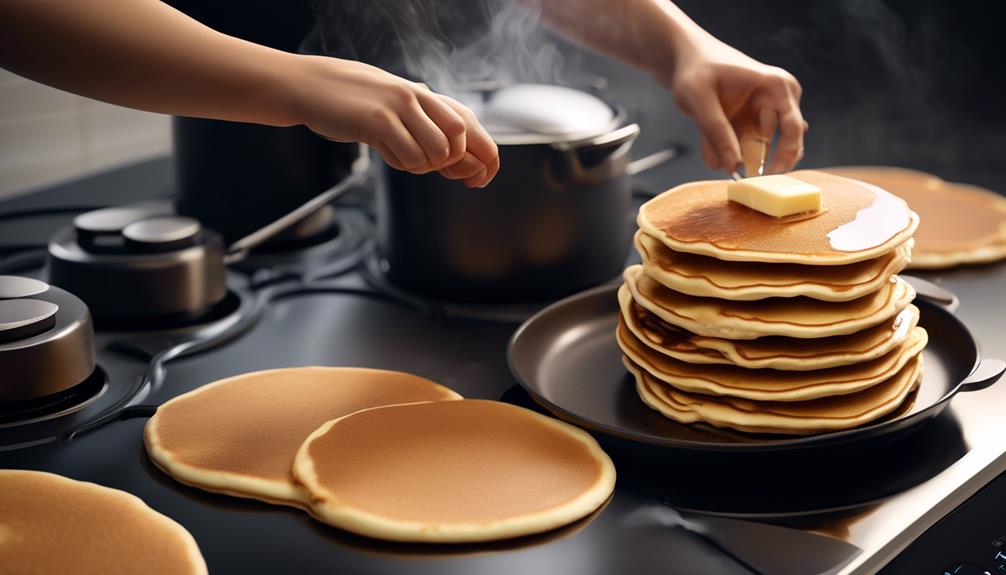
How can an induction stove be used efficiently for cooking pancakes?
When using an induction stove for cooking pancakes, it's essential to ensure safety and maximize energy efficiency. Here are some tips to help you achieve optimal results:
- Choose the right cookware: Select pans with a flat, magnetic base that can efficiently transfer heat from the induction cooktop to the pancake batter.
- Utilize the power settings: Induction stoves offer precise control over heat levels. Start with medium heat to preheat the pan and then adjust to lower heat for cooking the pancakes evenly.
- Avoid overheating: Induction stoves can quickly reach high temperatures, so monitor the heat level closely to prevent overheating the pan and burning the pancakes.
- Optimize pan size: Use a pan that matches the size of the heating element to ensure uniform heating and efficient energy usage.
- Utilize residual heat: After turning off the induction stove, take advantage of the residual heat to finish cooking the remaining pancakes, saving energy and ensuring consistent results.
Achieving Golden-Brown Perfection
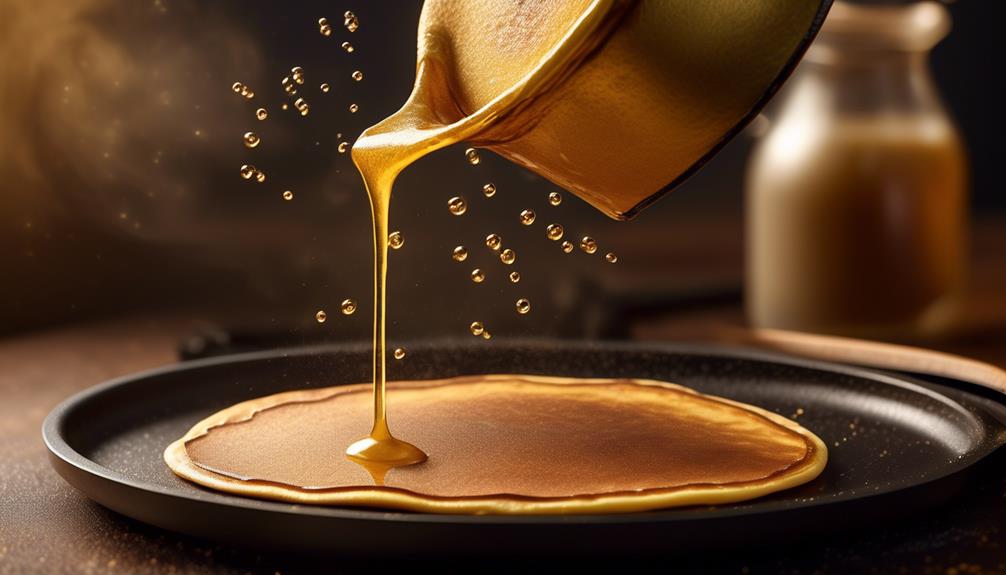
When achieving golden-brown perfection in pancake cooking on an induction stove, our focus shifts to mastering the heat control and timing, building upon the efficient use of the induction stove previously discussed. Achieving the ideal consistency and perfect flipping of pancakes relies on precise heat management and timing. To ensure the perfect outcome, we need to pay attention to the heat settings and the timing of flipping the pancake. Here's a table summarizing the key points for achieving golden-brown perfection:
| Key Aspect | Description | Action |
|---|---|---|
| Heat Control | Adjust the heat to medium-low | Maintain consistent heat |
| Timing of Flipping | Bubbles form on the surface | Flip when the edges appear cooked |
| Ideal Consistency | Pancake is golden-brown on both sides | Check for even browning |
| Perfect Flipping | Use a spatula to flip the pancake | Ensure a smooth and swift motion |
Tips for Fluffy Pancakes
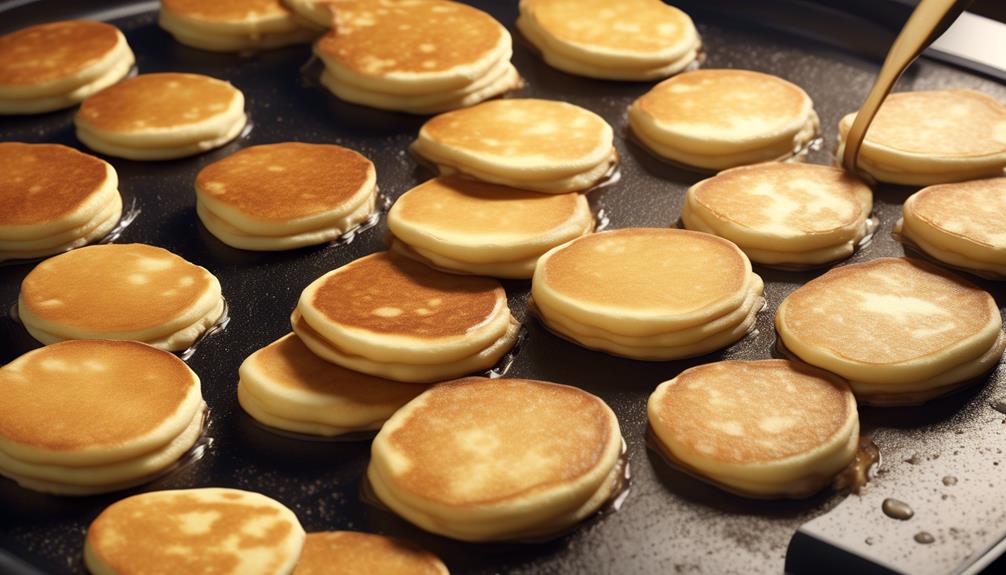
To achieve fluffy pancakes, it's essential to carefully measure and sift the dry ingredients to ensure a light and airy batter. The following tips will help you achieve the perfect fluffy texture and master the flipping technique:
- Batter Consistency: Achieving the ideal batter consistency is crucial. It should be thick enough to hold its shape on the griddle but still spread slightly. Adjust the liquid-to-dry ingredient ratio as needed to achieve this perfect balance.
- Use Buttermilk: Buttermilk adds a tangy flavor and helps create a tender, fluffy texture. Its acidity reacts with the leavening agents, resulting in a lighter and fluffier pancake.
- Don't Overmix: Overmixing the batter can lead to tough, dense pancakes. Mix the ingredients until just combined, leaving some lumps in the batter. This will ensure a tender and fluffy result.
- Flipping Technique: When it's time to flip the pancakes, use a spatula to gently lift and flip them. Avoid pressing down on the pancakes, as this can deflate the air pockets and result in a less fluffy texture.
- Adjust Heat: Maintain a consistent medium-low heat. Cooking pancakes too quickly can lead to uneven cooking and a less fluffy result. Patience is key to achieving fluffy perfection.
Mastering these flipping tips and paying attention to batter consistency will lead to consistently fluffy pancakes every time.
Tips for Thin Crepes
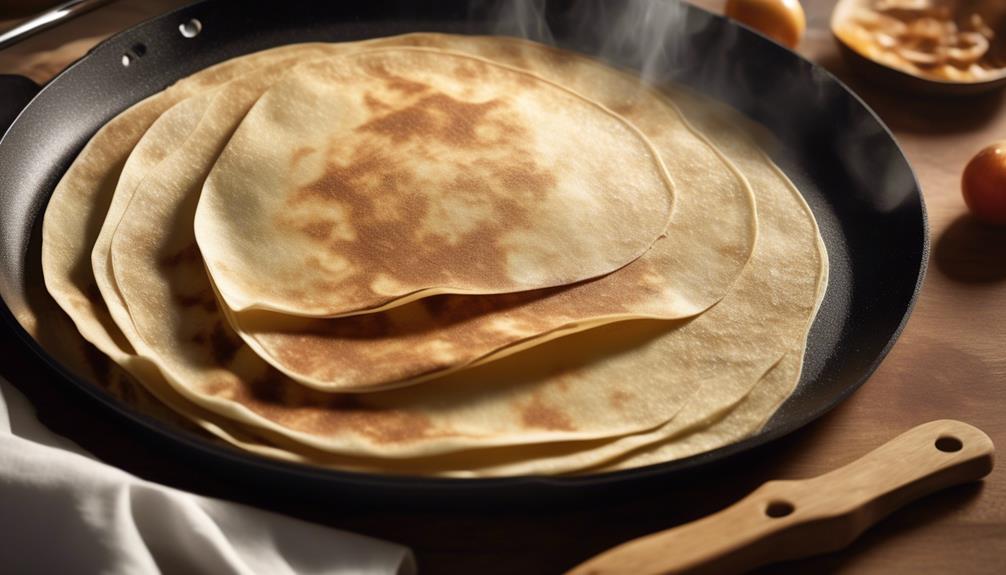
After mastering the art of achieving fluffy pancakes, the precision and technique required to create thin crepes can be equally rewarding. Thin crepes, a staple of French cuisine, require a delicate touch and attention to detail. To achieve mastery in making thin crepes, it's important to focus on the batter consistency, cooking technique, and presentation.
| Crepe Filling | Crepe Toppings |
|---|---|
| Fresh fruits | Whipped cream |
| Chocolate spread | Maple syrup |
| Savory vegetables | Powdered sugar |
Firstly, the batter should be quite runny, almost like heavy cream, to ensure the crepe spreads thinly and evenly in the pan. Secondly, using a well-seasoned crepe pan or non-stick skillet with low, consistent heat is crucial for achieving that perfect golden-brown color. Lastly, when it comes to serving, the filling options are endless, from sweet fillings like fresh fruits and chocolate spread to savory options like vegetables. Toppings such as whipped cream, maple syrup, and powdered sugar can elevate the flavors and presentation. With these tips, one can master the art of creating thin crepes, a delicate and delicious treat suitable for any occasion.
Mastering the Pancake Flip

We achieve a successful pancake flip by swiftly sliding a spatula beneath the pancake and confidently lifting it before swiftly flipping it over. Mastering the pancake flip is crucial for achieving that perfect golden brown color and even cooking on both sides.
Here are some key points to consider:
- Flipping Technique: It's essential to use a quick and assertive motion when flipping the pancake. A hesitant or slow flip can lead to a misshapen or unevenly cooked pancake.
- Pancake Batter Consistency: The thickness of the pancake batter can affect the ease of flipping. A slightly thicker batter can make flipping easier, as it holds its shape better.
- Ingredient Variations: Experimenting with different ingredients, such as adding a bit of cornstarch or using buttermilk, can alter the texture and structure of the pancake, impacting the flipping process.
- Flipping Methods: Some cooks prefer the classic spatula flip, while others may opt for the more daring wrist flick. Exploring different flipping methods can help find the one that works best for you.
- Practice and Patience: Mastering the pancake flip takes practice. Don't be discouraged by a few failed flips—keep practicing, and you'll soon become an expert at this essential pancake-making skill.
Perfecting the pancake flip requires attention to detail and a willingness to experiment with different techniques and ingredients. With practice, you'll become adept at achieving that flawless flip every time.
Frequently Asked Questions
Can I Use a Griddle or Non-Stick Pan Instead of a Stove for Cooking Pancakes?
Yes, we can use a griddle or non-stick pan instead of a stove for cooking pancakes. Both options provide even heat distribution and a smooth surface for pancake flipping.
When using a griddle, set the heat to medium-low to prevent burning, while a non-stick pan can be heated over medium heat.
Proper flipping techniques are essential to achieve perfectly cooked pancakes on either surface.
How Can I Prevent Pancakes From Burning or Sticking to the Pan?
To prevent pancakes from burning or sticking to the pan, we control the temperature carefully and use the right flipping technique.
It's essential to adjust the heat to medium-low and preheat the pan, allowing the pancakes to cook evenly.
When flipping, slide a spatula under the pancake and swiftly turn it over.
Non-traditional toppings and pancake art add creativity and variety to pancake making, making it a delightful culinary experience.
Are There Any Special Considerations for Cooking Pancakes at High Altitudes?
When cooking pancakes at high altitudes, adjustments to the recipe and techniques are crucial. The lower air pressure at higher altitudes affects the cooking process, potentially leading to batter rising too quickly or not enough.
To compensate, we recommend decreasing leavening agents, increasing liquid, and lowering cooking temperature. These adjustments foster the ideal fluffy texture.
What Is the Best Type of Oil or Butter to Use for Cooking Pancakes?
For cooking pancakes, the ideal cooking temperature is medium-low to ensure even cooking without burning.
When choosing between butter and oil, both work well, but butter adds a rich flavor and a slightly crispy texture.
When it comes to oil options, neutral-tasting oils like vegetable or canola are good choices as they won't overpower the pancakes' flavor.
Ultimately, the choice between butter and oil depends on personal preference and desired flavor impact.
Can I Use a Cast Iron Skillet to Cook Pancakes, and if So, Are There Any Special Instructions for Doing So?
Absolutely, you can use a cast iron skillet to cook pancakes. It's like cooking pancakes on a campfire, the heat distribution is even.
Preheat the skillet over medium heat and lightly oil it. A cast iron skillet retains heat well, so adjust the temperature as needed to prevent the pancakes from burning.
Using a wok for pancakes is also possible, just ensure it's seasoned well and preheated evenly for consistent results.
Conclusion
In conclusion, we've determined that the optimal heat for cooking pancakes is essential in achieving the perfect golden-brown texture and fluffy or thin consistency. By following the recommended temperature guidelines for gas, electric, or induction stoves, and mastering the pancake flip, you can elevate your pancake game to new heights.
Remember, a scientific approach to heat control is the key to pancake perfection. Keep flipping and sizzling, pancake enthusiasts!
- About the Author
- Latest Posts
Introducing Ron, the home decor aficionado at ByRetreat, whose passion for creating beautiful and inviting spaces is at the heart of his work. With his deep knowledge of home decor and his innate sense of style, Ron brings a wealth of expertise and a keen eye for detail to the ByRetreat team.
Ron’s love for home decor goes beyond aesthetics; he understands that our surroundings play a significant role in our overall well-being and productivity. With this in mind, Ron is dedicated to transforming remote workspaces into havens of comfort, functionality, and beauty.
Garage Door Opener
What Are the Benefits of a Bicycle Garage Door Opener?
Harness the power of convenience with a bicycle garage door opener, transforming your cycling routine with effortless access – discover the hidden benefits that await!

Have you ever thought about how a bicycle garage door opener could transform your cycling routine?
The benefits extend beyond mere convenience, offering a seamless way to access your garage effortlessly.
But that's just the beginning.
By exploring the various advantages this innovative device brings to cyclists, you will discover a whole new dimension to your riding experience.
Key Takeaways
- Seamless and hands-free operation for quick bike access.
- Enhanced security features with remote access control.
- Space optimization in the garage for easy bike storage.
- Integration with smart home technology for remote control and automation.
Enhanced Convenience and Accessibility
Bicycle garage door openers revolutionize the way cyclists access their garages by providing seamless and hands-free operation. These innovative garage door openers allow cyclists to effortlessly open and close their garage doors without the need to dismount from their bikes. With wireless capabilities, users can operate the garage door from a distance, offering unparalleled convenience.
The compatibility of these garage door openers with a wide range of garage doors makes them a versatile accessory for cyclists. The ability to open the garage door remotely not only enhances convenience but also adds an extra layer of security by reducing the need to leave bikes unattended outside. Cyclists can now enjoy a liberated cycling experience knowing that their garage is easily accessible and secure with the use of a bicycle garage door opener.
Improved Security Features for Peace of Mind

Enhancing garage security through advanced features ensures peace of mind for cyclists utilizing a bicycle garage door opener. The improved security features of a bicycle garage door opener provide a sense of liberation and confidence in the safety of your belongings.
Here are some key elements that contribute to the heightened security:
- Secure Access Control: The opener prevents unauthorized entry, keeping your garage and valuables safe.
- Remote Operation: Enjoy the convenience of opening and closing your garage door while on your bike, adding an extra layer of security.
- Wireless Capability: Operate the garage door from a safe distance, ensuring you can control access even when away from home.
- Wide Compatibility: Seamless integration with various garage doors enhances security by providing a tailored fit for your setup.
These security features, combined with the opener's durable and weather-resistant design, offer reliable protection against potential threats, allowing you to focus on your cycling adventures without worry.
Efficient Storage and Space Optimization
With the focus now shifting towards efficient storage and space optimization, the benefits of a bicycle garage door opener extend beyond just enhanced security features. A bicycle garage door opener helps maximize space utilization in a garage by efficiently storing and organizing bikes.
Designed specifically for bicycles, this opener allows easy access and storage without the need for manual lifting or awkward storage solutions, providing a convenient solution for daily use. By simply pressing a button, users can open and close the garage door swiftly, saving time and effort.
This efficient storage solution not only keeps bikes secure but also encourages their regular use, promoting an active lifestyle. With a bicycle garage door opener, users can make the most of their garage space, ensuring that their bikes are stored safely and conveniently, ready for their next adventure.
Seamless Integration With Smart Home Technology

Integrating a bicycle garage door opener with smart home technology allows for seamless control of the garage door remotely through various devices and platforms. This integration offers a range of benefits for users seeking convenience and security in managing their garage access.
Here are some key advantages:
- Remote Operation: Easily control the garage door using smartphone apps, voice commands, or smart home hubs.
- Scheduled Automation: Set automatic opening and closing times to enhance security and provide peace of mind.
- Global Accessibility: Monitor and control garage access from anywhere in the world, ensuring constant oversight.
- Enhanced Home Automation: Connect the garage door opener to other smart devices for improved overall home automation and security features.
Enhanced Cycling Experience and Lifestyle Benefits
Having a bicycle garage door opener not only provides cyclists with quick and convenient access to their bikes but also promotes a more active lifestyle by removing barriers to cycling. With the simple click of a button, riders can effortlessly retrieve their bikes from the garage, encouraging spontaneous rides and making cycling a more accessible activity.
This enhanced accessibility fosters a regular cycling routine, leading to improved fitness levels and overall well-being. The time and effort saved by using a garage door opener can be redirected towards enjoying the cycling experience itself, making each ride more enjoyable and fulfilling.
Additionally, the added security of being able to quickly store bikes indoors reduces the risk of theft or damage, giving cyclists peace of mind. Overall, a bicycle garage door opener enhances the cycling experience, promotes a healthier lifestyle, and contributes to a more active and liberated way of living.
Frequently Asked Questions
How Many Cycles Is a Garage Door Opener Good For?
We typically design our garage door openers to handle a specific number of cycles before requiring a battery replacement.
The Doormate for road bikes usually lasts up to 10,000 cycles, while the Doormate 2 for mountain bikes can handle around 20,000 cycles. These estimates are based on average use and may vary due to factors like frequency of use and environmental conditions.
Regular maintenance and timely battery replacements are key for optimal performance and longevity.
What Are the Pros and Cons of a Belt Drive Garage Door Opener?
Belt drive garage door openers offer quiet operation, durability, and low maintenance, making them ideal for homes with nearby living spaces. Although initially pricier, they can save on long-term repair costs.
These openers provide smooth, reliable function with minimal noise and vibration. However, they may not be suitable for heavy doors or extreme weather conditions due to belt limitations.
What Are the Disadvantages of a Wall Mount Garage Door Opener?
We've found that wall mount garage door openers can be a bit tricky. They take up wall space, might require professional installation, and could have limited range.
They're not as versatile as portable options and may not work with all garage doors. So, for some folks, wall mount openers mightn't be the best choice due to these limitations.
What Are the Benefits of a Smart Garage Door Opener?
Smart garage door openers offer convenient access without the hassle of keys or remotes. They provide wireless control up to 30 ft (9 m) away, perfect for cyclists who want easy operation without dismounting.
With long-lasting lithium-ion batteries and IP65 water resistance, these devices are durable and reliable in all weather conditions. Enjoy secure garage access without the fuss while cycling.
Conclusion
In conclusion, a bicycle garage door opener offers cyclists a seamless and efficient way to access their garage with ease.
With enhanced convenience, security features, and smart home integration, this device is a practical investment for any cycling enthusiast.
It's like having a key to your garage door right at your fingertips, making it a must-have accessory for a smooth and hassle-free cycling experience.
- About the Author
- Latest Posts
Introducing Ron, the home decor aficionado at ByRetreat, whose passion for creating beautiful and inviting spaces is at the heart of his work. With his deep knowledge of home decor and his innate sense of style, Ron brings a wealth of expertise and a keen eye for detail to the ByRetreat team.
Ron’s love for home decor goes beyond aesthetics; he understands that our surroundings play a significant role in our overall well-being and productivity. With this in mind, Ron is dedicated to transforming remote workspaces into havens of comfort, functionality, and beauty.
Garage Door Opener
How to Program Your MVP Garage Door Opener Remote
Uncover the secrets of programming your MVP Garage Door Opener remote with precision and patience, unlocking a world of possibilities.

When you’re setting up your MVP Garage Door Opener remote, think of it as giving your car keys the power to unlock endless possibilities. But how can we make sure this process is smooth and efficient every time?
Well, there's a method to the madness that involves precision and patience. Let's unravel the mysteries of syncing your remote with the garage door opener, troubleshooting any glitches, and perhaps discovering some insider tips that could make your garage access a breeze.
Key Takeaways
- Prepare the remote and enter programming mode with designated button sequences.
- Sync the remote and opener by inputting a 9-digit code for secure connectivity.
- Test the remote by sending signals to ensure seamless garage door control.
- Troubleshoot issues like unresponsiveness or non-functional buttons for effective remote programming.
Remote Preparation
To prepare the MVP Garage Door Opener remote for programming, we must first ensure it's in programming mode by pressing the designated buttons. The remote features three buttons: the + button, the – button, and the opener button. Pressing the + button followed by the – button puts the remote into programming mode.
Once in programming mode, you can proceed with assigning the opener button for the garage door. This button will be used to activate the garage door opener. After selecting the opener button, input a 9-digit code using the remote to link it to your garage door opener. This step is crucial for establishing a secure connection between the remote and the garage door opener.
Accessing Programming Mode

To access programming mode on the MVP Garage Door Opener, hold down the + button until the LED light flashes. This indicates that the unit is ready for programming. Once the LED light starts flashing, you can proceed with setting up your remote for use with the garage door opener. To give you a clearer picture, let's take a look at the following table:
| Button Action | LED Response | Wall Mount |
|---|---|---|
| Hold + Button | LED light flashes | Wall mount secure |
| Press – Button | Select programming | Wall mount stable |
| Enter 9-digit code | Sync remote | Wall mount aligned |
Syncing With Garage Door Opener
After successfully accessing programming mode by holding down the + button until the LED light flashes, the next step is syncing the MVP Garage Door Opener remote with the garage door opener.
To sync, press and hold the + button on the remote, then press the – button to enter programming mode. Once in programming mode, select a button on the remote to link with the garage door opener and input the provided 9-digit code.
The LED on the remote will flash, indicating successful syncing with the garage door opener. This process ensures that the remote is now paired and ready for use.
Syncing the remote allows for seamless communication between the remote and the garage door opener, enabling you to conveniently control the garage door with a simple button press. Proper syncing is crucial for the remote to function effectively, providing you with the freedom to operate your garage door effortlessly.
Testing the Remote

Testing the remote involves pressing the + button on the handheld device to ensure the MVP garage door opener functions correctly. To properly test the MVP garage door opener remote, follow these steps:
- Check the LED Light: Press the + button on the remote and ensure that the LED light on the device illuminates. This indicates that the remote is sending a signal to the garage door opener.
- Observe the Door Opening: After pressing the button, observe the garage door to ensure it responds to the signal from the remote. The door should start opening, confirming that the remote is effectively controlling the opener.
- Multiple Tests for Verification: To confirm the smooth functioning of the MVP garage door opener, test the remote multiple times. This ensures consistency and reliability in controlling the garage door.
Troubleshooting and Tips
For optimal troubleshooting and useful tips when working with your MVP Garage Door Opener remote, it is essential to understand common issues and effective solutions. If you encounter problems during programming, ensure that the LED on the remote flashes when in programming mode. Confirm successful programming by inputting the 9-digit code and testing the remote's functionality. If you face difficulties, consult the manual, online resources, or seek professional help. Consider purchasing a new remote if reprogramming attempts fail to ensure smooth garage door operation.
| Common Issues | Solutions |
|---|---|
| Remote not responding | Check battery levels and reprogram if needed |
| LED not flashing in programming | Replace batteries and retry programming mode |
| Button not working | Clean the button or consider replacing the remote with a new one |
Frequently Asked Questions
How Do I Program My MVP Remote?
To program your MVP remote, follow these steps:
- Press and hold the + button, then the – button to enter programming mode.
- Select the desired button and input the 9-digit code provided.
- Link the remote to one or multiple garage door openers for convenience.
The process is straightforward: enter the code and choose the operational button. This method ensures seamless functionality for your MVP garage door opener remote.
Where Is the Learn Button on My MVP Garage Door Opener?
The learn button on your MVP Garage Door Opener is typically situated near the antenna wire on the motor unit. This small, often round button, available in various colors like red or yellow, is pivotal for programming your opener.
Pressing this button puts the opener into programming mode, enabling you to sync new remotes or reprogram existing ones. The learn button's accessibility is key for smooth programming and convenience.
How Do I Reprogram My Garage Door Remote?
We reprogram garage door remotes by entering programming mode and linking a button to the opener.
A 9-digit code is input for programming. The MVP opener is versatile, able to work with multiple remotes. Security is ensured with over 19,000 preprogrammed codes.
Successful programming is indicated by the red LED light, and confirmation is given by releasing buttons after 5 seconds.
Testing functionality ensures proper operation post-reprogramming.
How Do I Pair My Garage Door Remote?
We pair our garage door remote by pressing and holding the + button to enter programming mode.
Then, we input a unique 9-digit code by pressing the desired button on the remote.
Once the LED indicator flashes, we know programming was successful.
To test, we press the programmed button to operate the garage door.
Pairing the remote offers convenient and secure access to our garage, enhancing our overall experience.
Conclusion
In conclusion, programming your MVP Garage Door Opener remote is as crucial as calibrating a precision instrument. By following the outlined steps meticulously, you can ensure seamless operation and enhanced security for your garage.
Just like a well-oiled machine, your remote will now function flawlessly, providing you with convenient access to your garage whenever needed.
- About the Author
- Latest Posts
Introducing Ron, the home decor aficionado at ByRetreat, whose passion for creating beautiful and inviting spaces is at the heart of his work. With his deep knowledge of home decor and his innate sense of style, Ron brings a wealth of expertise and a keen eye for detail to the ByRetreat team.
Ron’s love for home decor goes beyond aesthetics; he understands that our surroundings play a significant role in our overall well-being and productivity. With this in mind, Ron is dedicated to transforming remote workspaces into havens of comfort, functionality, and beauty.
Garage Door Opener
Craftsman Garage Door Opener Battery Backup Installation Guide
Dive into the essential steps for installing the Craftsman Garage Door Opener Battery Backup to safeguard your garage access in critical moments.

Let’s address the installation of the Craftsman Garage Door Opener Battery Backup in a systematic manner.
As we navigate through the intricacies of setting up this essential backup system, we'll uncover key insights that can make all the difference in ensuring a seamless integration.
Stay tuned as we unravel the nuances of this process, shedding light on crucial steps that could be the game-changer in safeguarding your garage access during unforeseen situations.
Key Takeaways
- LED lights indicate battery status for seamless operation
- Replacement batteries available for around $90 from Sears
- Troubleshooting may involve battery replacement for functionality
- Understanding system intricacies crucial for uninterrupted operation
Battery Backup System Overview
When considering the Battery Backup System Overview for the Craftsman garage door opener, it's essential to understand its fundamental role in ensuring uninterrupted operation during power outages. The battery backup system is a crucial component of the Craftsman garage door opener, providing power during outages to maintain continuous functionality.
LED lights on the opener display different colors to indicate the battery status, with green signaling normal operation and red indicating error detection. This feature significantly enhances the reliability and performance of the garage door opener, especially during power disruptions.
Sears offers replacement batteries specifically designed for the Craftsman garage door opener, with replacements typically priced around $90. Troubleshooting the battery backup system may involve replacing the battery if indicated as faulty, following Sears' installation guidance to ensure proper functioning.
Understanding the intricacies of the battery backup system is vital for ensuring the seamless operation of the Craftsman garage door opener during power outages.
Required Tools and Materials

To successfully install the Craftsman garage door opener battery backup, gather essential tools such as a screwdriver, ladder, and possibly a drill for mounting, along with specific materials like the battery backup unit, mounting brackets, screws, and wiring harness. When preparing for the installation, it's crucial to ensure you have the following tools and materials ready:
- Screwdriver: Necessary for removing panels and securing components during the installation process.
- Ladder: Used to access and work on the garage door opener system safely at elevated heights.
- Drill: Optional but may be needed for mounting the battery backup unit securely in place.
- Mounting Brackets, Screws, and Wiring Harness: These are essential components for attaching the battery backup unit to the garage door opener and connecting it effectively.
Before beginning the installation, always prioritize safety precautions by disconnecting power sources and following the manufacturer's guidelines meticulously to prevent any accidents.
Step-by-Step Installation Instructions
Let's begin with the step-by-step installation instructions for integrating the Craftsman Garage Door Opener battery backup system. Follow these detailed steps to ensure a smooth installation process:
Craftsman Garage Door Opener Battery Backup Installation Steps:
| Steps | Actions | Tips |
|---|---|---|
| Step 1 | Turn off the power to the garage door opener. | Ensure safety by disconnecting the power source. |
| Step 2 | Locate the motor unit of the garage door opener. | The backup battery will be connected here. |
| Step 3 | Connect the backup battery to the motor unit. | Follow the provided instructions for proper installation. |
| Step 4 | Check the LED lights on the opener to verify battery status. | Green light indicates full charge; red light signals low battery. |
| Step 5 | Test the garage door opener with the backup battery. | Ensure seamless functionality during a power outage. |
Testing and Troubleshooting

We'll now proceed to assess the functionality of the Craftsman Garage Door Opener battery backup system through a series of tests and troubleshooting procedures.
- Check LED Lights: Look at the LED lights on the garage door opener. Green indicates normal operation, yellow signals backup power engagement, and red suggests an error requiring service.
- Test Keypad Codes: Ensure you're using the correct keypad codes for both the wall mount opener and the remote to operate the garage door.
- Inspect Trolley Engagement: If the trolley disengages due to power loss, re-engage it according to the manufacturer's instructions.
- Red Light Indicator: If the red light persists after troubleshooting, contact a professional for service on the garage door opener.
Maintenance Tips and Safety Precautions
Inspecting and lubricating the moving parts regularly ensures smooth operation and extends the longevity of your Craftsman Garage Door Opener. To maintain optimal performance and safety, keep the photo-eye sensors clean and properly aligned for the safety reversal system to function correctly. Periodically test the battery backup system to ensure it is ready for any power outages. Check for any loose hardware and tighten as needed to prevent accidents or malfunctions. It is essential to schedule professional maintenance at least once a year to address any potential issues and ensure the garage door opener operates efficiently.
| Maintenance Tips and Safety Precautions | ||
|---|---|---|
| 1. Inspect and lubricate moving parts | 2. Clean and align photo-eye sensors | 3. Test battery backup system |
| Regular inspection and lubrication keep the garage door opener running smoothly. | Ensure sensors are clean and aligned for proper safety function. | Verify battery backup readiness for power outages. |
| 4. Check for loose hardware | 5. Schedule professional maintenance | |
| Tighten any loose hardware to prevent accidents. | Annual maintenance ensures optimal performance. |
Frequently Asked Questions
How Do You Replace a Craftsman Garage Door Opener Battery?
We start by replacing a Craftsman garage door opener battery by checking the LED lights for status:
- Green for normal,
- Yellow for backup,
- Red for error.
We then proceed to purchase a replacement battery for about $90. We can find these batteries and installation guidance from Sears.
Common issues that may signal the need for battery replacement include:
- Trouble closing the door,
- Specific keypad codes,
- Trolley disengagement,
- A red service light.
Can You Add a Battery Backup to an Existing Garage Door Opener?
Yes, we can add a battery backup to an existing garage door opener. It's a simple upgrade that ensures seamless operation during power outages.
How Do You Install a Garage Backup Battery?
When installing a garage backup battery, we begin by ensuring the power is disconnected for safety.
Then, locate the designated terminals on the garage door opener and securely mount the battery.
Connect the battery to the terminals following the manufacturer's instructions carefully.
Test the backup battery regularly to confirm it's charged and ready to provide power during outages.
This will ensure uninterrupted operation of the garage door opener when needed.
Is Garage Door Opener Battery Backup Worth It?
Absolutely, having a garage door opener battery backup is totally worth it! It ensures continuous access to your garage, even during power outages, offering both convenience and security.
With seamless operation and no manual intervention required, the peace of mind it provides is priceless. The investment in a battery backup system for your garage door opener is a smart choice for anyone seeking uninterrupted accessibility in emergency situations.
Conclusion
In conclusion, installing a Craftsman garage door opener battery backup is a smart investment for ensuring your garage door operates smoothly even during power outages.
Did you know that 70% of homeowners experience at least one power outage every year? By following the step-by-step guide provided, you can easily set up your battery backup system and enjoy peace of mind knowing your garage door will always be functional.
- About the Author
- Latest Posts
Introducing Ron, the home decor aficionado at ByRetreat, whose passion for creating beautiful and inviting spaces is at the heart of his work. With his deep knowledge of home decor and his innate sense of style, Ron brings a wealth of expertise and a keen eye for detail to the ByRetreat team.
Ron’s love for home decor goes beyond aesthetics; he understands that our surroundings play a significant role in our overall well-being and productivity. With this in mind, Ron is dedicated to transforming remote workspaces into havens of comfort, functionality, and beauty.
-

 Vetted3 weeks ago
Vetted3 weeks ago15 Best Drip Irrigation Systems to Keep Your Garden Thriving
-

 Vetted3 days ago
Vetted3 days ago15 Best Foot Massagers for Neuropathy to Soothe Your Feet and Relieve Discomfort
-

 Vetted1 week ago
Vetted1 week ago15 Best Sports Laundry Detergents for Keeping Your Activewear Fresh and Clean
-

 Vetted2 weeks ago
Vetted2 weeks ago15 Best Tall Toilets for Seniors That Combine Comfort and Safety
-

 Vetted2 weeks ago
Vetted2 weeks ago15 Best Dish Scrubbers to Keep Your Kitchen Sparkling Clean
-

 Beginners Guides4 weeks ago
Beginners Guides4 weeks agoDesigning Your Retreat Center – Essential Tips
-

 Beginners Guides4 weeks ago
Beginners Guides4 weeks agoAre Retreats Profitable
-

 Decor2 weeks ago
Decor2 weeks agoWhat Is Eclectic Home Decor










